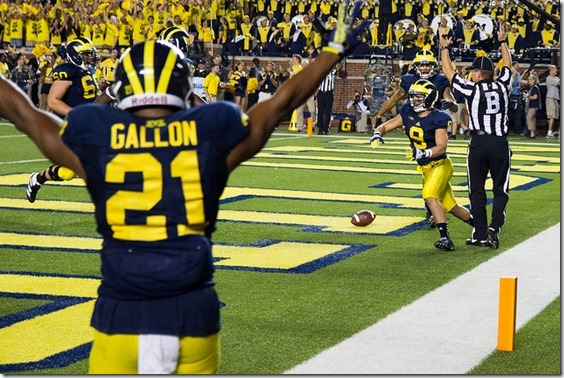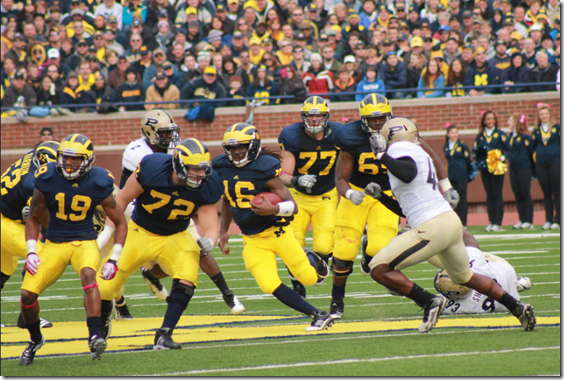i come up with an incredibly complicated solution to something that may not be a problem
Can you name all the Michigan players in this photo from the last Purdue-Michigan game in Ann Arbor? [photo: a much younger Eric Upchurch]
Since going to 14 teams the Big Ten schedule has been a mess. Some teams rarely face each other, other teams face each other twice a season. The divisions are historically and presently uneven. The last two years in a row this resulted in a Big Ten “champion” that had a demonstrably worse season than at least two other Big Ten teams. Congrats Penn State and Michigan State, but I think we can do better. In fact I have an idea how.
I’ll get into the details below but the idea isn’t for everyone to have to memorize the details. The simplest description is every year you play three locked-in rivalry games, three games of your choosing, and three games against schools near you in the standings. Your biggest rivalry is played at the end of the season, and its result (half) carries over to next season.
On FiveThirtyEight’s Solution: Nate Silver’s proposal and mine share a few concepts: locked in rivalries early in the year, a mini-playoff at the end of the year, and eradicating divisions (which is essential to any good schedule reform). But it has two big flaws I tried to avoid:
1) It puts The Game in September, which: no, or in Week 7, which again: no, and then you’re seeding with less information.
2) Teams at the top will rarely face those at the bottom. I don’t like that because it cuts down on variety and could easily lead to things like long droughts between Michigan-Purdue tilts which are one of the things we’re trying to fix. Also it’s not good for the long term health of the conference since it would redistribute more losses from the bottom of the conference to the middle and middle-high. In effect it would result in fewer and lower ranked teams at the top, and fewer bowl-eligible teams from the conference. A few more competitive games is good, but 538’s proposal takes that to an extreme to the detriment of other important considerations.
Goals:
- Maintain the annual rivalries and maximize their importance, keeping the big rival games at the end of the season.
- Play 9 conference games.
- Split up rivalry games so every team has a compelling schedule every year to sell to season ticket holders.
- Produce a fair and least disputable conference champion by playing all or most of the relevant games during the season.
- Play as many competitive games between similarly ranked teams as possible.
- No rematches!
- See a variety of opponents over a 10-year period.
- Encourage Power 5 opponents in non-conference scheduling.
- Be relatively simple.
The system I came up with hit all of these benchmarks to varying degrees (#9 being measured in Kelvin). #5 conflicts with #7 so I left it up to the schools themselves to prioritize between them. As for #9 it’s actually complicated, but can have the appearance of simplicity.
The schedule has four components:
- Three locked-in games versus your annual rivals.
- Three games where the top teams draft their opponents.
- Three games where you play like competition, and the top four teams all play each other.
- A “Big Ten Showcase” invitational during conf championship week to play the best three games that weren’t played.
DIVISIONS
This is the easy part. The teams are all separated into four pods of three or four with rivals they ought to be playing every year.
| Grp | Big Two, Little Bro | East Coast Cable Subscribers | Intercollegiate Conference of Maladroit Representatives | Corn Corn Corn Corn Cheese Corn Corn Corn |
|---|---|---|---|---|
| A | Michigan | Rutgers | Illinois | Wisconsin |
| B | Ohio State | Maryland | Northwestern | Minnesota |
| C | Michigan State | Penn State | Indiana | Iowa |
| D | x | x | Purdue | Nebraska |
The division names are not important but the order is—if you want a clue as to why, look at the A-B and C-D matchups. Teams in your pod are the two or three teams you play every year. There are two ways to handle the three-team pods and I haven’t decided which I like better—either works about the same:
- Option 1: Lock in rivals. Each team gets an annual rival from the opposite division, e.g. Michigan-Maryland is played the week of OSU-MSU, PSU-OSU always comes when Michigan plays State, and Rutgers-Michigan State is played annually on the last week of the season for bragging rights and the Situation Trophy.
- Option 2: Rotate every 2 years. So after two seasons of the above, Michigan plays Rutgers on week 1, Ohio State plays Maryland, and the Land Grant Trophy becomes the end-of-year rivalry for MSU. Then after two years it becomes M-PSU, OSU-Rutgers, MSU-Maryland.
I sorta prefer Option 1 but Option 2 seems more feasible.
[HIT THE JUMP to see how I worked it all out]
[Upchurch]
We had a little preseason meeting of the MGoBloggerati last week. Due to some oversight, we unfortunately had this meeting at a bar with TVs and the Lions preseason game on those TVs. So no, we didn't get much planning done with a table full of football bloggers who had football in front of them, but Brian had this fantastic idea:
What if the NFL preseason actually counted? Teams would have unlimited rosters, but you could only play your 1st stringers for the 1st quarter, and your 2nd stringers in the 2nd, and so on. Play in a quarter and you lose your eligibility for the rest of them. Everybody wins!
In things that somebody wins:
Football season means we're gonna start getting back to picking daily/weekly fantasy games to congregate in with our fantasy partner Draft Kings. This week's is an NFL preseason contest because frankly that's what we're all paying attention to right now (sorry boss). And since it's early we just went with a free one anyone can play:
Details:
- $100,000 prize pool.
- First place wins $10,000
- FREE for everyone to join - no deposit required
- Top 23,150 scores win guaranteed
- Starts on Sunday, September 13th at 1:00 PM EST
- Salary Cap Style Drafting. $50,000 to select 9 spots. 8 players and 1 defense.
- Roster Format: 1 QB, 2 RB, 3 WR, 1 TE, 1 Flex and 1 Defense
- Hit the link to join.
Smart pick:
I noticed Kelvin Benjamain has torn his ACL. Although the rookie vying to take his targets tweaked his hamstring last week and missed the Miami game, Funchess should be good to go. And the nice thing is you have to scroll a loooong way to get to him.
Previously: overview.

feeling that a ticket you have is a precious thing is good
More games should mean things
This is something that Brandon was moving towards getting right, save for the horrible contract that saw him eat an extra Notre Dame home game at the (hopefully temporary) end of that series. And that contract might not have been his doing.
This year's football schedule has one tomato can on it, UNLV, and three actual teams: BYU, Oregon State, and Utah. BYU and Oregon State are one-off home games. They're more expensive, but we've finally reached the point where spending an extra few hundred thousand dollars on an opponent like that has a clear ROI in ticket sales. (That is the reason Brandon was getting that right.) One of the smartest things he said during his tenure was about this.
Unfortunately, I have been able to google it to get the exact quote, but it was along the lines of "we have to get out of the business of scheduling games that feel like exhibitions to fans." He largely put his money where his mouth was in that department. Or tried to, anyway. It still galls that Michigan State landed a home and home with Alabama and Michigan was forced to play a "neutral" site matchup in Dallas against them.
But Brandon was right: repeated tomato can poundings make the fan look at his ticket and feel like a sap. The Product™ boils down to that: you look at the ticket that has a section and seat and opponent on it and you feel a certain way. For years many of these tickets have made you feel like it's another way to pay for the Ohio State game. That is going to remain true, but being less explicit about it is a first step on the road towards making fans feel like part of the enterprise instead of marks.
There's not much flexibility when it comes to college football. Michigan's going to play in their division and they've got three games a year (Indiana, Rutgers, Maryland) that aren't going to feel like much no matter what happens. They've been filling out the nonconference schedule with more respectable opponents; further additions have to happen a decade or more out. The wider landscape of college football will help here: double the number of teams in the playoff means double the number of late-season games that can impact the championship picture.
![500x281[1] 500x281[1]](https://mgoblog.com/sites/mgoblog.com/files/images/Athletic-Director-Time-Stakes_9341/500x2811.png)
Michigan's other two revenue sports could use some help. This year's hockey schedule was a textbook example of what not to do: a weird one-off at Ferris State before even the exhibition games, home games piled into the fall when most fans are busy with football, an almost two-month absence from Yost in January and February punctuated by a fiasco of an outdoor game taken in by fewer fans than would have been at a home game.
Meanwhile, basketball plays a lot of nonconference games against the Coppin States of the world. It was seven last year (they just happened to lose two): Hillsdale, Bucknell, Detroit, Nicholls State, NJIT, EMU, and Coppin State. I don't see a great solution there given the way college basketball works: you're going to have a preseason tournament, you're going to have a game just before Christmas no one wants to play, there's not enough room to do anything interesting.
The conference, though… the conference could use some tweaking. Here are a couple of concrete plans to make basketball and hockey games have more wow factor on the ticket.
Basketball: making 14 an asset
Wisconsin ran away with the Big Ten title this year. Their last seven games included matchups against 9-9 Illinois, 4-14 Penn State, and two against 6-12 Minnesota. What if their stretch run was nothing but the other three games—Maryland, Michigan State, Ohio State—and so was everyone else's? And what if you could never point to anyone's schedule and say that's why team X won?
This is possible, even in a 14-team conference if you're willing to rethink a conference schedule. You can have a true, fair, thrilling championship in 19 conference games:
- FIRST 13: round-robin amongst all teams
- LAST 6: split the league into top and bottom halves, have second round-robin within.
Everyone in each half plays the same schedule. The last three weeks of the regular season are an all-out brawl for a banner that means something it might not in a world where getting the wrong teams twice could knock you down a peg.
The downsides are real but not insurmountable. You would not know the last six games of your schedule until a few days before. With home sites that's not a huge problem. There will be demand for those games. And teams right around the cutoff could find their path to a bid get harder as teams just above it draw a bunch of tough games and teams below it lose the opportunity to knock off a Wisconsin. That effect is probably marginal (on average it's turning three games into somewhat harder or easier ones).
If they tried this I bet they would never even think about going back once they saw, say, Iowa, Michigan, Michigan State, Wisconsin, OSU, Indiana, and Illinois have a three-week war for a Big Ten title.
Hockey: a state championship
![Wigan-celebrate-FA-Cup-wi-005[1] Wigan-celebrate-FA-Cup-wi-005[1]](https://mgoblog.com/sites/mgoblog.com/files/images/Athletic-Director-Time-Stakes_9341/Wigan-celebrate-FA-Cup-wi-0051.jpg)
The FA Cup: the only time anyone has ever believed in Wigan
There's not a whole lot Hypothetical Michigan AD can do about the Big Ten or NCAA's playoff format. (It does sound like the national tournament is in line for some long-overdue changes.) But he can probably get the Michigan schools together to provide early-season matchups some additional oomph.
The formation of the Big Ten is something college hockey needed if they were ever going to expand past two western conferences, but it broke up a bunch of 40-year-old rivalries that mean something to college hockey fans. Instead of having every Michigan team save Tech in a single conference, now they're spread across three. The GLI has tried to compensate by inviting a Michigan team for the foreseeable future, but that doesn't do much for the three teams that aren't invited in any particular year.
Nor does it have that much selling power. The GLI is a nice event, but it's always been a little silly that Michigan has a banner for years they won it. It's two games. The trophy doesn't have a name. It's not, say, a 40-pound bronzed cast of Red Berenson's head.
What if the first half of the season had a different competition in it? Soccer does this to excellent effect. A state championship competition that features World Cup/Champions League style groups would be a reasonable time commitment and a way to inject stakes into otherwise fuzzy early-season matchups.
A problem: there are seven Michigan teams, not eight. We will fill in the eighth spot with a guest program. This could either rotate between reasonably local programs (ND, OSU, BGSU, Miami, even PSU) or be permanent.
Hypothetical groups:
| GROUP A | GROUP B |
|---|---|
| Michigan | Michigan State |
| Notre Dame | Western Michigan |
| Michigan Tech | LSSU |
| Northern Michigan | Ferris State |
Each team plays the others twice, whether that's home and home or not. The next year invert home/road and do it again; then switch the groups up. The only hard and fast rule is that Michigan and Michigan State are separate. The four teams in the bottom two rows are all WCHA members. They can either book an early-season conference series to count for the state championship or schedule bonus nonconference series, their choice.
After that's done, the top two in each group play for the Michigan Themed Hockey Trophy* at the Joe. (The other two also go to the Joe and play because everyone wants to know they've got X number of games booked.)
This is a commitment of eight games—six for teams currently in the WCHA. For teams in the Big Ten (20 conference games), Hockey East (22), or NCHC (24) that is doable. It does seriously restrict the flexibility of WCHA teams (28 games), but a lot of these games are the ones these schools would want to schedule anyway. For example, Ferris's nonconference schedule included two games against State, one against Michigan, and the GLI. Tech played Michigan and in the GLI. They would be signing up for another two or three games only. And the lack of flexibility is offset by the fact that they're locking in a Michigan or Michigan State series annually.
If you can pull this off then your early season, normally something without stakes other than the hope down the road your Pairwise ranking will be good, becomes three weekends in which you hope to qualify for a GLI that means you can print out shirts that say State Champs and kiss let's just say a 40-pound bronze cast of Red Berenson's head.
![130624233204-stanley-cup-trophy-horizontal-large-gallery[1] 130624233204-stanley-cup-trophy-horizontal-large-gallery[1]](https://mgoblog.com/sites/mgoblog.com/files/images/Athletic-Director-Time-Stakes_9341/130624233204-stanley-cup-trophy-horizontal-large-gallery1.jpg)
like this except with Red Berenson's head
Play for things. Give us stakes. A ticket that reads "Red Berenson's 40 Pound Head Tournament" is better than one that just says "Western Michigan."
*[Options: unearth the Ron Mason trophy that went kaput when the CCHA did, inaugurate a Red Berenson trophy for the former Michigan player and Detroit Red Wing, or go studiously neutral but somewhat silly by naming it after a guy who didn't play college hockey.
Gordie Howe played in the defunct minor-pro version of the USHL for a year, not the CHL, and he's Gordie Howe. So he's a good idea if you're going that route.]


131